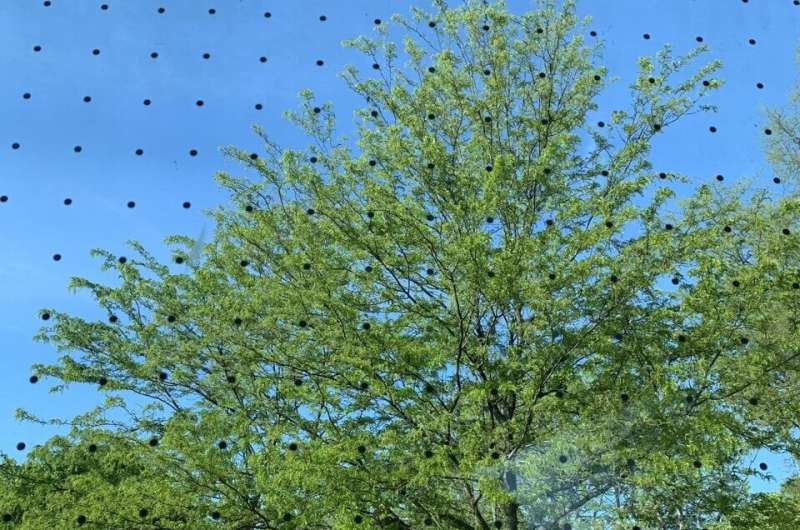This article has been reviewed according to Science X's editorial process and policies. Editors have highlighted the following attributes while ensuring the content's credibility:
fact-checked
trusted source
proofread
Preventable loss: A billion birds die each year from window strikes

University of Cincinnati ornithologist Ron Canterbury displayed dozens of birds that died from striking glass windows in the city.
It's a tiny fraction of those he and his students have collected in recent years for his long-term study on window-strike mortality. Here were magnolia warblers, American redstarts, white-throated sparrows, tiny hummingbirds and larger mourning doves and woodpeckers.
"It's depressing," he said.
Canterbury said these fatal collisions are having a significant effect on bird populations.
"Silent spring is coming," Canterbury said, referencing the famous Rachel Carson 1962 book that inspired the environmental movement of the 1970s. "The urgency is now."
As many as 1 billion birds die each year across the country after striking glass windows, according to the U.S. Fish and Wildlife Service. Some individual buildings are the site of thousands of bird mortalities each year. The losses are not incidental, Canterbury said.
Canterbury has been studying bird mortality in Ohio for more than a decade and wild bird populations for 37 years. Even most dead birds are protected by federal law, so he needs a permit to collect them for his lab. He and his students walk a regular route to look for victims of window strikes in Cincinnati.
Some of the birds end up as mounted museum displays across the country. Others are used in the classroom to teach biology and ornithology. But they all end up getting recorded for Canterbury's ongoing mortality study.
"Some birds like blue jays that are not long-distance migrants are better at avoiding windows," Canterbury said. "But others are super-colliders—and they're at risk of extinction."
One such super-collider is the ovenbird, a spotted warbler with an orange crest that nests in mature woodlands.
"For every bird I find, you can multiply that many times over because you're losing so many baby birds that year as well," he said.
He worries that the ovenbird will follow the fate of golden-winged warblers, a species he has studied intensively in the Appalachians mountains. They, too, used to breed in Ohio. But golden-winged warblers have seen one of the biggest population declines of any bird in the past 50 years.
"They're in bad shape compared to when I started studying them 30 years ago," Canterbury said. "The last one I banded in Ohio as a breeding bird was 1998. They're in real trouble."
Species on the brink
Canterbury said golden-winged warblers are considered an "umbrella" species, or one that through protection of its habitat protects other species. People love the colorful, little birds and want to protect them, which helps protect other imperiled species that rely on the same habitats.
Some cities have launched lights-out campaigns to darken large office buildings at night so as to not interfere with migrating birds.
"Many of the birds I study, like sparrows, buntings, finches, warblers and thrushes, migrate at night," Canterbury said.
The artificial light draws birds closer to cities where they are more likely to run afoul of windows and vehicle traffic, another big killer of birds.
"They're often attracted to the lights of cities, which is creating a serious environmental issue," he said.
Since some birds can fly as high as the world's tallest mountains (the Rüppell's griffon vulture has been seen flying at 37,000 feet), people might think that birds hit every floor of a building. But Canterbury said most collisions occur on the lowest three floors where birds see the reflections of landscaping or tree branches in the glass.
Glass connectors between buildings pose an especially big problem for birds, especially if there are trees or a landscaped courtyard on one side, he said.
Simple ways to help
Federal regulators and nonprofit groups such as the National Audubon Society say there are lots of ways people can prevent deadly bird impacts on windows.
- Glass films featuring a visible pattern of squares or circles can help break up the illusion of open space.
- Patterned parachute cord can create a visual barrier for birds.
- Tempera or poster paint can provide a simple, temporary solution during spring or fall migration. It washes away with water and vinegar.
- Permanent solutions include custom-made glass featuring etched patterns or frost and ultraviolet patterned glass that is invisible to people but can be seen by birds.
"Basically, anything that disrupts the reflection of trees in the windows will work," he said.
And for aggressive resident birds that peck their reflection, there is a similar easy solution. Canterbury said people can cover that window until the bird begins to nest and loses its aggressive disposition.
Canterbury said to help birds is to help ourselves. They help rejuvenate forests by spreading seeds.
"Birds eat millions of mosquitoes each year, so they help prevent the spread of mosquito-borne illness," he said. "The decline of birds could affect human health, too.
"As they decline, it's spelling big trouble for the health of ecosystems."
Provided by University of Cincinnati


















